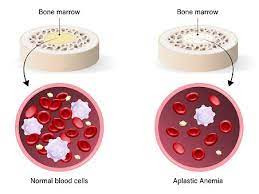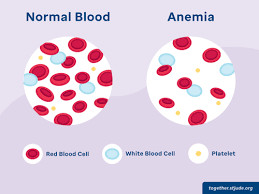Definition
Aplastic anemia is a condition in which the body fails to produce a sufficient number of new red blood cells. This occurs due to a disruption in the stem cells within the bone marrow, which affects the production of blood cells. The bone marrow, located in the center of bones, is crucial in producing blood cells and platelets.
This blood disorder is considered rare and serious, and it can affect individuals of all ages. Aplastic anemia increases the body's susceptibility to infections and uncontrollable bleeding. The disease can onset suddenly or gradually, worsening over time.
Causes
The stem cells in the bone marrow produce various types of blood cells, including red blood cells, white blood cells, and platelets. In aplastic anemia, damage to these stem cells reduces the number of these blood cells. This can lead to either aplasia, where there is a complete absence of blood cells, or hypoplasia, where there is a decreased number of blood cells in the bone marrow.
Doctors often may not identify the specific cause of aplastic anemia. However, several known factors can damage the bone marrow and impact blood cell production, including:
- Radiation therapy and chemotherapy: These treatments, while effective against cancer cells, can also affect healthy cells, including stem cells in the bone marrow, potentially causing temporary aplastic anemia.
- Exposure to toxic chemicals: Certain chemicals in pesticides, insecticides, and compounds like benzene in gasoline have been associated with aplastic anemia. Avoiding repeated exposure to these chemicals may improve the condition.
- Use of certain medications: Drugs such as chloramphenicol, sulfonamide antibiotics, medications for rheumatoid arthritis, and antithyroid drugs have been linked to aplastic anemia.
- Autoimmune diseases: A common cause is autoimmune disorders, in which the immune system targets and attacks healthy cells, including stem cells in the bone marrow, leading to aplastic anemia.
- Viral infections: Infections caused by Epstein-Barr, cytomegalovirus, HIV, or parvovirus B19 have been associated with developing aplastic anemia.
- Pregnancy: The immune system may target the bone marrow during pregnancy, possibly due to increased estrogen levels. The exact mechanism is still unknown.
- Fanconi anemia: This rare inherited disease, diagnosed through blood tests, can cause aplastic anemia. Children with Fanconi anemia may exhibit developmental abnormalities, such as underdeveloped limbs.
Risk factor
Aplastic anemia is a rare disease. Factors that can increase the risk of developing this condition include:
- Cancer patients undergoing high-dose radiation therapy or chemotherapy.
- Frequent exposure to toxic chemicals or compounds.
- Having rheumatoid arthritis or thyroid disorders and undergoing treatment.
- Suffering from blood disorders, autoimmune diseases, or certain serious infections.
- Pregnancy can increase the risk of anemia, although aplastic anemia is rarely found in pregnant women.
Symptoms
The symptoms of aplastic anemia can vary, and some individuals may experience no symptoms at all. However, symptoms typically arise due to the lack of red blood cells and may include:
- Fatigue
- Increased and irregular heartbeat
- Pale skin
- Shortness of breath
- Easy bruising
- Increased susceptibility to infections or prolonged infection
- Nosebleeds or gum bleeding
- Difficulty stopping bleeding, such as from wounds
- Rash
- Dizziness
- Headaches
- Fever
Diagnosis
The doctor will thoroughly assess your symptoms, medical history, and family history, along with any ongoing treatments. A physical examination will also be performed. Additional tests are necessary to evaluate your blood levels further.
The following tests aid in the diagnosis of aplastic anemia:
- Blood tests: These tests assess the levels of red blood cells, white blood cells, and platelets. Low levels of all three types of blood cells are typically observed in aplastic anemia. This includes:
- Low red blood cell count or low hemoglobin levels (anemia)
- Low levels of immature red blood cells or reticulocytes
- Low white blood cell count (leukopenia)
- Low platelet count (thrombocytopenia)
- Bone marrow biopsy: In this procedure, a small sample of bone marrow is extracted using a needle, usually from a large bone. The sample is then examined under a microscope in a laboratory. In aplastic anemia, the bone marrow typically shows fewer than normal blood cells and an increase in fat. Confirming the diagnosis of aplastic anemia often requires a bone marrow biopsy.
Management
Treatment for aplastic anemia varies depending on the severity of the condition and the patient's age. It may include:
- Blood transfusions
While blood transfusions cannot cure aplastic anemia, they can help control bleeding and improve symptoms by providing blood cells that are not adequately produced by the bone marrow. Patients with aplastic anemia may receive red blood cells or platelets.
However, repeated transfusions can lead to complications. In red blood cell transfusions, excess iron from the transfused blood can accumulate in the body and damage vital organs if not addressed. Additionally, over time, treatment with transfusions may become less effective as the body can develop antibodies against transfused blood. This can become life-threatening if blood cell levels become very low. To reduce the likelihood of these complications, immunosuppressive drugs may be used
- Stem cell transplantation
Recommended treatment for severe cases of aplastic anemia, particularly in individuals under the age of 50. This procedure requires a fully matched donor, usually a sibling.
Before transplantation, the patient may undergo radiation or chemotherapy to prepare the body. Healthy stem cells from the donor are then injected into a vein, where they travel to the bone marrow and produce new blood cells. Following transplantation, patients receive treatment to prevent rejection of the donated stem cells.
- Medication
Immunosuppressive drugs may be used for patients who cannot undergo stem cell transplantation or in cases of aplastic anemia caused by autoimmune diseases. These drugs suppress the immune system, allowing the bone marrow to recover and produce new blood cells. Additionally, certain medications can stimulate the bone marrow to produce new blood cells.
Patients with severe aplastic anemia may also receive antibiotics or antivirals to prevent infections, as the weakened immune system makes them more susceptible.
Complications
Aplastic anemia can lead to various complications, including an increased risk of infections and bleeding and a heightened risk of developing serious blood disorders. If left untreated, aplastic anemia can contribute to heart disease, such as arrhythmias (irregular heart rhythms), heart enlargement, or heart failure.
Prevention
Because the cause of aplastic anemia is often unknown, it can be challenging to prevent it. However, it's crucial to consult a doctor regarding any medications or underlying diseases that may increase the risk. Additionally, avoiding exposure to certain toxic chemicals, such as insecticides, herbicides, organic solvents, paint removers, and other hazardous substances, can help reduce the risk of aplastic anemia.
When to see a doctor?
If you experience unexplained bleeding or bleeding that is difficult to stop, or if you have frequent infections or unusual fatigue, it's important to consult your doctor or go to the nearest emergency department.
Looking for more information about other diseases? Click here!
- dr. Yuliana Inosensia
Aplastic anemia (2022) Mayo Clinic. Mayo Foundation for Medical Education and Research. Available at: https://www.mayoclinic.org/diseases-conditions/aplastic-anemia/symptoms-causes/syc-20355015 (Accessed: March 7, 2023).
Aplastic anemia (2022) MedlinePlus. U.S. National Library of Medicine. Available at: https://medlineplus.gov/aplasticanemia.html (Accessed: March 7, 2023).
Aplastic anemia (no date) Mount Sinai Health System. Available at: https://www.mountsinai.org/health-library/diseases-conditions/aplastic-anemia (Accessed: March 7, 2023).











